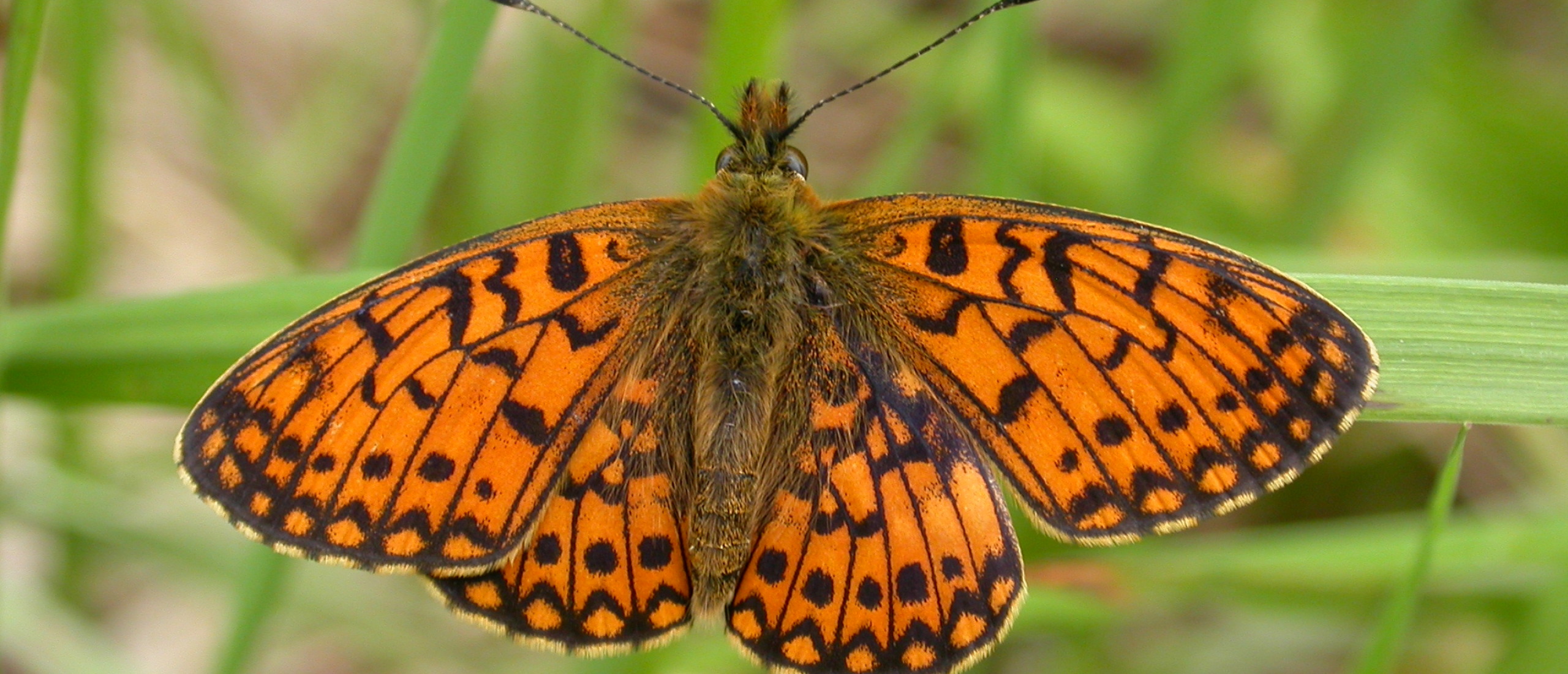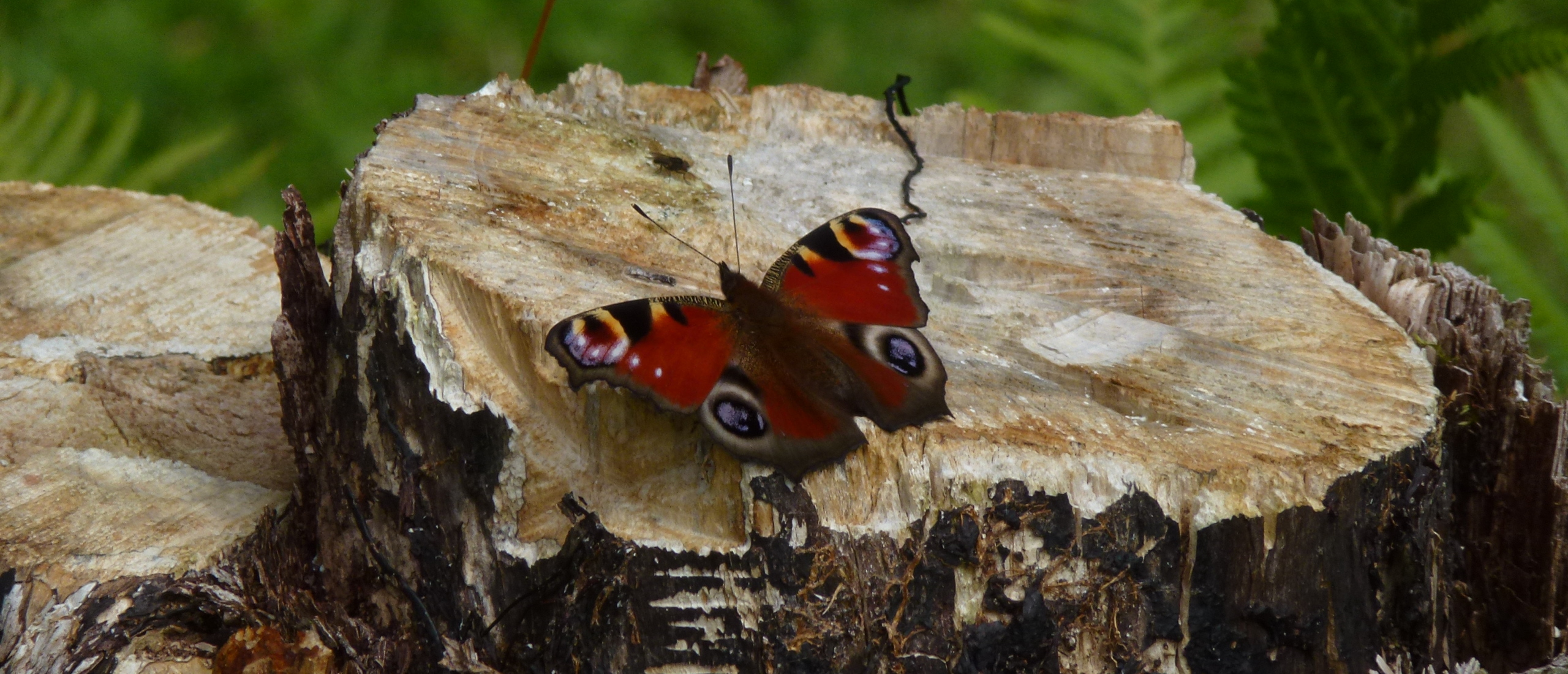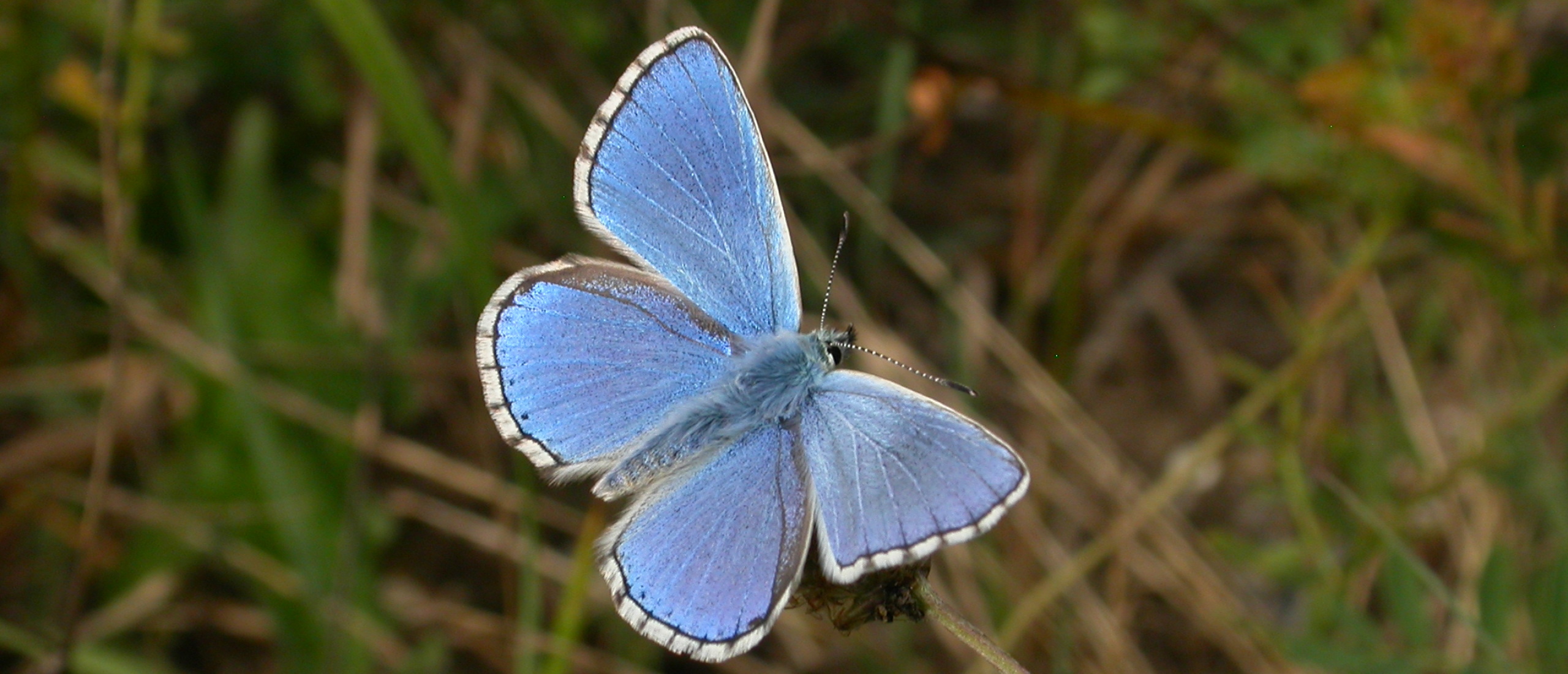
Who says Belgium is boring? Today was one of my most successful butterfly days of the year, with 23 species seen (as many as I saw during my entire stay in Scotland), and I could easily have found more had I not restricted myself to one location. With two particular target species in mind, I headed eastwards into Belgium, arriving at around 11 AM at the Fondry des Chiens, an area of chalk downland with some extraordinary rock formations, sculpted by the rain over millennia into bizarre shapes, and formerly the haunt of ne'er-do-wells and brigands. Today the brigands came in the form of two teenaged boys with a ghetto blaster, blaring out "music" at different locations around the rocks, trying to find the best acoustic spot. So much for peaceful nature reserves.
 The extraordinary rock formations of the Fondry des Chiens
The extraordinary rock formations of the Fondry des Chiens
Luckily, butterflies are not disturbed by noise, and I spotted a Purple Hairstreak, Neozephyrus quercus, fluttering around an oak tree in the car park before I had even left the car. I later went on to find three of these elusive denizens of the canopy, including one which posed quite low down, but I was unable to prepare my camera quickly enough to get its photograph before it flew off. After only a few seconds of walking on the open grassland, I spotted butterfly species number 74 for the year, the beautiful pearly Chalkhill Blue, Lysandra coridon. This butterfly is common here, and by the end of my visit I must have seen more than 100 individuals. They were extremely active in the bright, warm sunshine, and did not allow a close approach for photography.
Other open-country butterflies in evidence here were several Berger's Clouded Yellows, Colias alfacariensis, the white females laying their eggs on Horseshoe Vetch, Hippocrepis comosa, and several much deeper orange Clouded Yellows, Colias croceus, whose rapid flight made them look like little fireballs skittering over the hillside. Numerous Brimstones, Gonepteryx rhamni, were stocking up on nectar to see them through their long winter hibernation, and a couple of Wood Whites, Leptidea sinapis/reali, were in evidence near the patches of surrounding woodland/scrub. One of the most numerous butterfly species here today was the Wall, Lasiommata megera, a cheering sight as this species is in decline in many areas. On two occasions, much darker and slightly larger Wall-like butterflies flew past, one finally landing on a rocky outcrop in a deep ravine - these were a much rarer species, the Large Wall, Lasiommata maera. Sadly this one was too distant to photograph, and it did not open its wings. This is the only area in this region where I know this species to occur, and it obviously requires the warm micro-climate created by these unusual rocks - indeed it lives up to its Dutch name of Rotsvlinder, or Rock Butterfly.
 A beautiful Large Wall I photographed in the same spot on 29th August 2009
A beautiful Large Wall I photographed in the same spot on 29th August 2009
Further walking revealed several Small Heaths, Coenonympha pamphilus, Brown Arguses, Aricia agestis, Common Blues, Polyommatus icarus, and all three common Whites, as well as several Violet Fritillaries, Clossiana dia, including one which posed for long enough to allow me to obtain a decent shot; normally they are so active that photography is virtually impossible.
 A Violet Fritillary posing cooperatively - a rare sight!
A Violet Fritillary posing cooperatively - a rare sight!
In a more sheltered section of taller grassland, several patches of flowering Hemp Agrimony, Eupatorium cannabinum, were growing, their blooms proving particularly attractive to insects including a confiding Holly Blue, Celastrina argiolus, as well as a numerous rather Honey Bee-like species of Hoverfly, but they were in grave danger as I observed a single Hornet, Vespa crabro, literally pouncing on them, stinging them and then dismembering them immediately on the flowerheads.
 A Holly Blue nectaring on Hemp Agrimony
A Holly Blue nectaring on Hemp Agrimony
A little away from the grassland, in a wooded glade, a large tawny butterfly proved to be a late and rather tired-looking Silver-washed Fritillary, Argynnis paphia; in fact, I went on to see perhaps five of this splendid butterfly, so clearly their season is not quite over. I also saw two slightly smaller fritillaries, which could either have been Dark Green, Argynnis aglaja, or High Brown, Argynnis adippe, but I could not be sure which.
 A faded Silver-washed Fritillary, with the sun shining through its worn-looking wings
A faded Silver-washed Fritillary, with the sun shining through its worn-looking wings
Returning to the grassland, I decided to have one more look for perhaps my most important target species, and it was not long before a browny-orange butterfly flew past me, and luckily landed on a low branch of an Oak tree: a beautiful, apparently pristine female Brown Hairstreak, Thecla betulae. Fumbling with my camera, I attempted a too close approach, and it flew off over the trees and was lost to sight. My usual technique is to snap a record shot with my Panasonic Lumix, which has a 16X zoom and does not require such a close approach, and then once I have obtained a few pictures, to move in for a close-up with my ancient and venerable Nikon Coolpix 4500, which despite only having 4 mega-pixels and a 4X zoom, takes far sharper shots. Here, foolishly I went straight for the Coolpix and approached too close, thereby spooking the Hairstreak into flight. Slightly annoyed with myself, I waited for a while, but there was no sign of its return, so I wandered slowly along the sunny bank of woodland at the back of the grassland, and my attention was drawn to a fluttering shape that disappeared under a leafy branch. This time I approached more stealthily, and had the Lumix on full zoom at the ready - a wise move, as it was indeed either the same or another perfect female Brown Hairstreak, and this time she posed so confidingly that I was able to use both cameras, and I even had to shake the branch she was on several times to encourage her to move to a more accessible spot!
 The beautiful Brown Hairstreak posing on a Beech leaf
The beautiful Brown Hairstreak posing on a Beech leaf
 The Brown Hairstreak, now on Oak
The Brown Hairstreak, now on Oak
Brown Hairstreaks are never easy to find. They live at low densities in areas with extensive stands of their larval foodplant, the Sloe, Prunus spinosa, but they also spend much time perched on other trees such as Oak, Ash, Beech or Hawthorn. Interestingly, their scientific name betulae suggests an association with Birch, Betula sp, but I have never observed a Brown Hairstreak near a Birch. Assessing their populations is more accurately achieved by searching for their pearly-white eggs, which can easily be found in winter in the V's formed where young twigs branch off the main stems of the Sloe bushes, than by searching for the elusive adults, which spend much time perched high in the surrounding Oaks and other tall trees.
 The Brown Hairstreak, this time taken with the Coolpix
The Brown Hairstreak, this time taken with the Coolpix
Although Brown Hairstreaks are theoretically on the wing from late July, they seem to be easier to observe later in the season, and they can go on until late September or even into early October. This one looked absolutely fresh, and yet it may have already been out for nearly a month. I wonder whether the emergence of this species is more staggered than that of other species, most of which emerge within a few days of each other. Whatever, the reason, I savoured my encounter with what was undoubtedly one of the absolute highlights of my butterfly year. As a final bonus, while mowing the lawn later in the afternoon, I disturbed a Clouded Yellow, Colias croceus, which then landed in a small Ash tree, allowing me to approach what is normally another very hard species to obtain close-up photographs of. All in all, one of my best butterfly days of 2013.
 A lovely, rich orange Clouded Yellow in the garden
A lovely, rich orange Clouded Yellow in the garden
2013 butterfly total as of 29th August: 75 species













